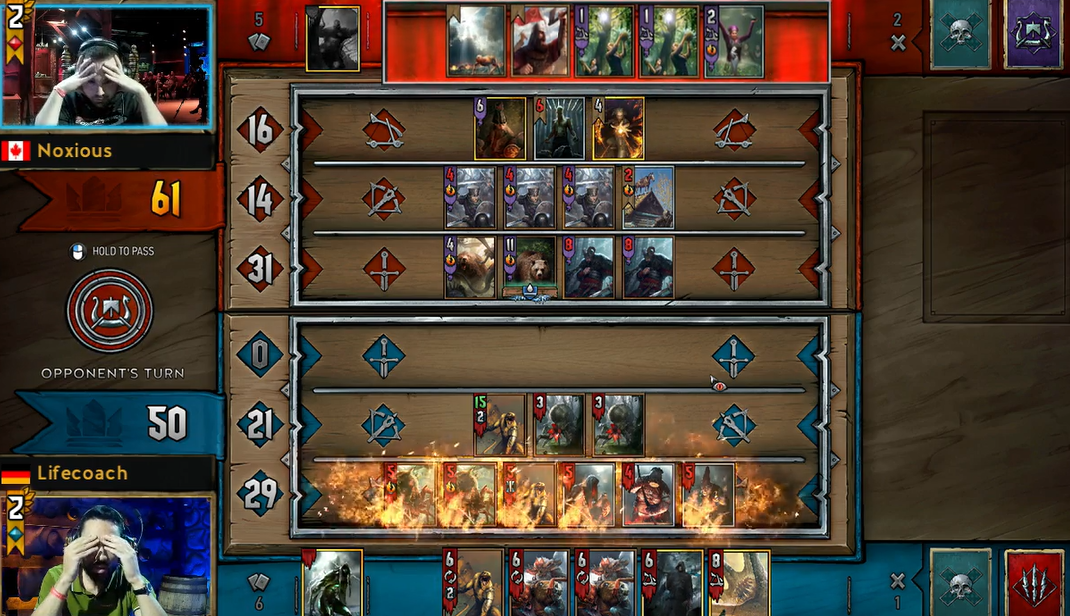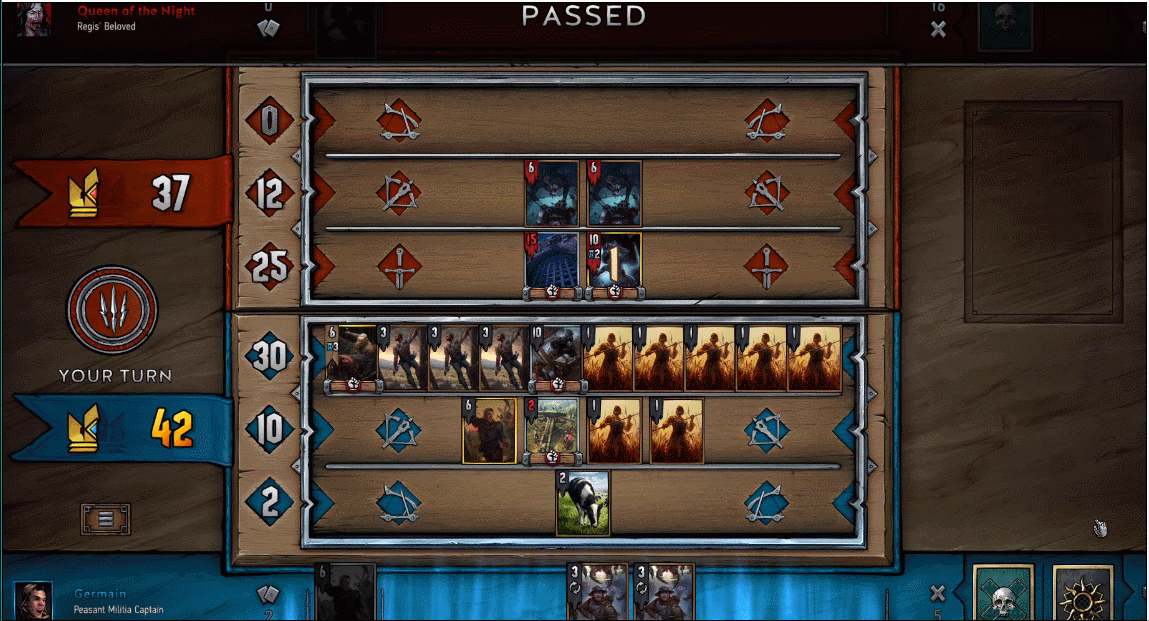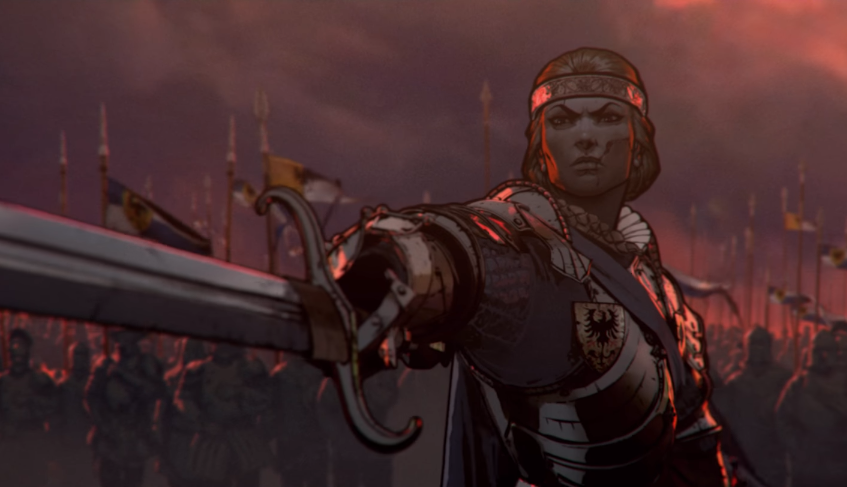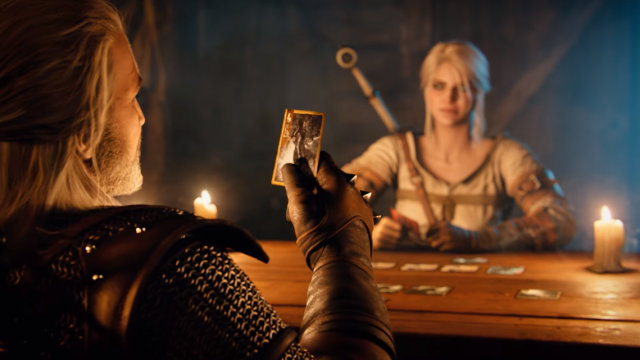The studio behind The Witcher series announced its spin-off card game Gwent back at E3 2016.
Over a year later the game still isn’t officially out yet, though CD Projekt Red clams it will launch before the end of 2017. During that time it’s grown into something special, so I’m here to say, if you still had any reservations about giving the game a shot, it’s time to set them aside.
I’ve spent over a hundred hours playing Gwent. Even more if you count the version embedded in The Witcher 3 that originally inspired it. How did I get to this point? I was accepted into the closed beta which began in October 2016.
The beta was a multiplayer card game predicated on collecting cards, building decks, and then playing against friends or strangers in online matches consisting of three rounds each. Playing matches and winning rounds earned you more cards or the currency to buy entire packs.
When the studio announced Gwent would become a standalone card game, many, myself included, didn’t think there was enough there to fulfil the expectations set by other game in the genre. After months of playing the game and watching how it’s evolved, it’s clear that’s no longer the case.
In my first months playing the beta, I accrued a not-insignificant collection of cards while playing on PC in-between checking my email and paying bills. Since the game is free-to-play, you can grow your collection entirely by using the currency earned in-game if you want. (If you’re not familiar with how the game works this is a very useful guide to the basics).
Months later, when the PS4 version went live, I switched over to playing it on console. By this summer barely a day went by that I didn’t whittle away an hour here or there playing one of my favourite decks; some imperial spies here, a smattering of elves and dwarves there, all the while playing against random people online I knew only through the emotes we exchanged during matches.
What games like Hearthstone and Clash Royale have become for so many, Gwent unexpectedly became for me: a routine habit like exercise or meditation where as much enjoyment comes from repeating familiar patterns as discovering new ones.

An infamous moment in the first major Gwent tournament when a Geralt fire spell card demolished the monsters on an opponent’s bottom row.
You could be forgiven for thinking building-sized murals of the game at this year’s E3 meant that Gwent was already out. For most people’s purposes, it is. You can download it on PC, Xbox One, or PS4 right now.
It’s clear though that the game hasn’t just been languishing in open beta making money off of people buying ornately illustrated packs of cards just because it could. New sets of cards, continued re-balancing of old ones, and now three separate sets of single-player challenges against AI opponents have all helped usher Gwent into something that’s both complete and goes beyond just another “me too” collectible card game.
Over the past year the game, which already deviated from the Witcher 3 version in important ways, continued to evolve. CD Projekt Red released Gwent‘s first update in mid-November of 2016.
In addition to tweaking the UI and fixing various bugs, it changed leader cards from being like all other “Legendary” ones and made them into unique “Epics.” They still counted as a card in your hand but would only last one round and were immune to certain effects.
In Gwent, every deck is built around a faction leader. When the game was first presented for people to play in The Witcher 3, that leader was simply a stand-in for a special ability that would trigger under certain conditions. By the standalone Gwent‘s closed beta, leaders had become distinct cards that could interact with others on the board.
For example Eredin, the head of the Wild Hunt that you battle at the end of The Witcher 3, went from being a special ability that could summon rain or fog in the original mini-game to an actual card that could be played as a unit like any other.
This change helped make them feel more like generals leading the charge than just personas to be adopted by the player. It’s also an example of how every card from the original set has been given new ways to interact with one another. Cards that once simply had a high or low power number now have secondary effects that lead to interesting trade-offs when deciding which ones to include in a new deck.
Subsequent patches made even more drastic alterations, to the point where someone who had ducked out of the game after a month of playing would find many of the current decks and strategies in popular rotation unrecognizable.

Another big change to the underlying game was the decision to do away with invincibility. In the beginning, Legendary gold cards were untouchable. Like all card games Gwent has tiers to denote how rare and powerful a given card is. Bronze are the lowest, followed by silver and then gold.
Every deck can only have a certain number of silver and gold cards, with the latter at one time being invincible to enemy spells and abilities. This made them feel true to the characters they represented in a way.
Yennifer would never succumb to a single fireball. But it also made the game more prone to deadlock and offered less opportunities for interaction between players.
In Gwent, rather than targeting another player or the creatures laid out in front of them, most cards simply do a thing. Tactics and strategy are more global as a result, and making a Geralt or a Ciri impervious had a way of disrupting combos and more complex outcomes.
Finally, perhaps the biggest improvements to Gwent have come in the form of weather effects. As a game played along three mirrored rows, matches play out like opposing armies lined up across from one another and trading volleys.
When Gwent was still just a mini-game in The Witcher 3, a weather spell would immediately drop the power of all units on a particular row down to one. It was devastating and overly simplistic.
Players would simply counter with Clear Skies, a card that erases weather effects, or simply counter with their own bad weather. As a result, the studio decided early in the closed beta to make these effects more granular. Currently, dropping frost or heavy rains on an enemy does a small amount of damage each turn instead of all at once.
This means some players will decide to try and cope with the effect and play from behind while others will add protection to their units to stave off the damage.
There are simply more things to consider with more possible solutions that can be explored. While the competitiveness of decks built around weather still comes and goes with each new patch, the mechanic itself has become much more interesting to play around with since back when the closed beta originally launched.

I haven’t even gotten to the most important part: Gwent‘s single-player campaign due out when the game officially launches in the next couple of months. It’s titled “Thronebreaker” and was created in part by some of the writers who worked on The Witcher 3.
Unlike the existing game which, outside of matches, is entirely menu-based, the story expansion is supposed to feature an overhead map with players selecting points of interest where story beats will play out in the context of a Gwent match.
If the current ongoing holiday event Saovine is any indication, this means something like villagers being attacked by vampires.
In Gwent, this state of affairs is represented by a deck of peasants and farmers being played onto a board where a special unit like a barricade or siege weapon needs to be protected for a certain number of rounds (by buffing or healing) in order to progress the story.
According to an update put out by the developers in late September, Thronebreaker will run about 15 hours and feature five different board setups and unique areas to travel to. It will also have hand-drawn cutscenes and unique cards that tell a story set before the events of the current Witcher games.
While it won’t be an opportunity to revisit the characters many have come to love from the recent game, it still has the intent of delivering a story that takes place in that world and has the kind of quality side-characters and voice acting fans of the series have come to expect.
Players have been waiting for Gwent‘s storyline expansion for some time, held over in the meanwhile by new sets of cards to collect and build decks with. I can’t fault the studio for waiting so long given how far the underlying design of Gwent has advanced during that period.
It’s not just that the game is set to finally come out of beta with a single-player story in toe, but that it will be doing so at a time when its features and mechanics have matured into a deep and compelling game.

Comments
3 responses to “Gwent Has Spent The Whole Last Year Getting Good”
Gwent is bloody brilliant.
A note if you’re the sort who wants to buy kegs (ie packs of cards) – you’ll accumulate them through play in any case, so you’ll pretty much get the best bang for your buck if you buy them when you start playing the game to avoid excessive amounts of dupes etc.
I loved playing gwent in the Witcher 3. LOVED IT! but spent about an hour total playing this version before ditching it.
I guess if I can’t buy a new sword with my winnings, I’m not interested.
I’m one of those that didn’t enjoy Gwent in Witcher 3, and so basically played through the game while avoiding it, so this game has never interested me.
I enjoyed the dice poker in Witcher 1 and 2 more than Gwent. While Gwent was no doubt more deep and strategic, it just…didn’t do it for me.